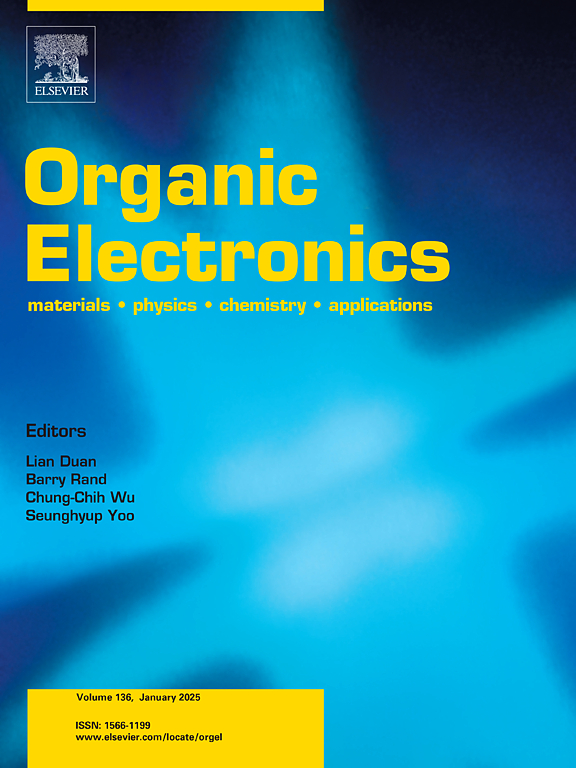Mitigating slow reverse ISC rates in TAPC:PBD exciplex via rapid Förster energy transfer to TTPA
IF 2.6
4区 工程技术
Q3 MATERIALS SCIENCE, MULTIDISCIPLINARY
引用次数: 0
Abstract
There have been many advances in the development of thermally activated delayed fluorescence (TADF) materials for organic light emitting diode (OLED) applications in recent years. In particular, intramolecular exciplex systems have been highly studied and found to produce OLED devices of high external quantum efficiency (EQE) due to triplet harvesting via TADF. The proposed next generation of OLEDs uses hyperfluorescence to overcome the problem of broad emission associated with exciplexes. This process involves Förster resonance energy transfer (FRET) from the TADF host to a fluorescent dopant. In this work we revisited the photophysics of the TAPC:PBD exciplex (formed between the electron donor di-[4-(N,N-di-p-tolyl-amino)-phenyl]cyclohexane (TAPC) and the electron acceptor, 2-(4-biphenyl)-5-(4-tert-butylphenyl)-1,3,4-oxadiazole (PBD)) as a host capable of simultaneously performing triplet harvesting and work as a donor transferring energy to a bright fluorescent emitter. The aim is to investigate the interplay between energy transfer and intersystem crossing in this hyperfluorescence system. Contrarily to previous findings, films of the TAPC:PBD blend show relatively slow reverse intersystem crossing rate (RISC) and weak luminescence efficiency (PLQY). Despite this, when doped with the strong fluorescent emitter TTPA, the luminescence quantum yield is greatly improved due to the highly efficient energy transfer rate from TAPC:PBD to TTPA. The rapid FRET from the exciplex to the fluorescent emitter overcomes the non-radiative losses affecting the luminescence efficiency of the blend. This study shows that the hyperfluorescence mechanism not only allows colour purity in OLEDs to be optimised, but also facilitates suppressing major loss mechanisms affecting luminescence efficiency, thus creating conditions to maximizing EQE.

通过快速Förster向TTPA的能量转移,减轻TAPC:PBD复合物缓慢的反向ISC速率
近年来,用于有机发光二极管(OLED)的热激活延迟荧光(TADF)材料的开发取得了许多进展。特别是,分子内异构体系统已经得到了高度的研究,并发现通过TADF捕获三重态可以产生高外量子效率(EQE)的OLED器件。提出的下一代oled使用高荧光来克服与杂合体相关的宽发射问题。这个过程涉及Förster共振能量转移(FRET)从TADF宿主到荧光掺杂剂。在这项工作中,我们重新研究了TAPC:PBD外合物(在电子供体二-[4-(N,N-二对苯基-氨基)苯基]环己烷(TAPC)和电子受体2-(4-联苯)-5-(4-叔丁基苯基)-1,3,4-恶二唑(PBD)之间形成)作为宿主,能够同时进行三重态收获和作为供体将能量转移到明亮的荧光发射器。目的是研究高荧光系统中能量传递和系统间交叉之间的相互作用。与以往的研究结果相反,TAPC:PBD共混薄膜表现出相对较慢的反向系统间交叉率(RISC)和较弱的发光效率(PLQY)。尽管如此,当掺杂强荧光发射器TTPA时,由于从TAPC:PBD到TTPA的高效能量转移率,发光量子产率大大提高。从异构体到荧光发射器的快速FRET克服了影响共混物发光效率的非辐射损失。本研究表明,高荧光机制不仅可以优化oled的颜色纯度,还可以抑制影响发光效率的主要损失机制,从而为最大化EQE创造条件。
本文章由计算机程序翻译,如有差异,请以英文原文为准。
求助全文
约1分钟内获得全文
求助全文
来源期刊

Organic Electronics
工程技术-材料科学:综合
CiteScore
6.60
自引率
6.20%
发文量
238
审稿时长
44 days
期刊介绍:
Organic Electronics is a journal whose primary interdisciplinary focus is on materials and phenomena related to organic devices such as light emitting diodes, thin film transistors, photovoltaic cells, sensors, memories, etc.
Papers suitable for publication in this journal cover such topics as photoconductive and electronic properties of organic materials, thin film structures and characterization in the context of organic devices, charge and exciton transport, organic electronic and optoelectronic devices.
 求助内容:
求助内容: 应助结果提醒方式:
应助结果提醒方式:


